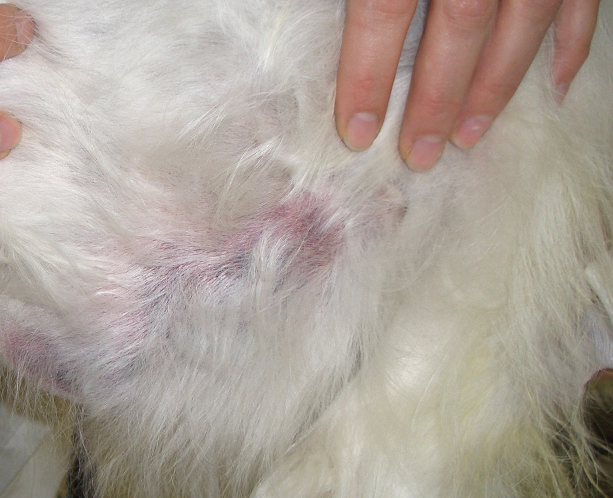Canine Infectious Diseases: Self-Assessment Color Review, Q&A 06
| This question was provided by CRC Press. See more case-based flashcards |

|
Student tip: This case is an example of an interesting clinical exam |
A 9-year-old neutered female mixed-breed dog living in Augsburg, Germany, was referred for a several-week history of dry cough and lethargy. The owner also noticed exercise intolerance and a decreased activity level. A 10-day course of treatment with enrofloxacin did not improve the clinical signs. The dog had no travel history outside 51 northern Europe. She was up to date on routine vaccinations; preventive treatment for parasites was unknown. On physical examination, the dog was lethargic with normal vital signs. On auscultation of the thorax, slightly harsh lung sounds were noted during inspiration and expiration; the heart sounds were normal. Cutaneous ecchymoses were noted on the ventral and lateral aspects of the abdomen (see image).
| Question | Answer | Article | |
| What are the differential diagnoses for the problems identified? | Cough can be of respiratory or cardiac origin. The nature of the cough and lack of signs of heart failure on physical examination (such as tachycardia, delayed capillary refill times, and poor pulse quality) made cardiac disease less likely in this case. Respiratory abnormalities can be localized to the upper or the lower respiratory tract. In this dog, there were no signs of upper respiratory disease (such as stridor), but increased lung sounds over the lung field suggested the possibility of lower respiratory tract disease. The cutaneous ecchymoses could be traumatic or secondary to a coagulation disorder. The latter was suspected because there was no history of trauma. Coagulation disorders can result from defects of primary hemostasis (vasculopathy, thrombocytopenia, thrombocytopathy) or secondary hemostasis (lack of coagulation factors). |
Link to Article | |
| What diagnostic tests would you perform? | Thoracic radiographs are indicated for further work-up of the cough. In addition, a CBC should be performed to evaluate for anemia and thrombocytopenia, as well as signs of infection or inflammation in the leukogram. Serum biochemistry and urinalysis should be performed to evaluate liver function (production of coagulation factors) and to assess for evidence of other systemic disorders that might contribute to coagulopathy. In addition, a coagulation profile should be performed. In heartworm endemic regions or dogs with a travel history to those regions, a heartworm antigen test would also be indicated.
|
Link to Article | |
To purchase the full text with your 20% discount, go to the CRC Press Veterinary website and use code VET18.
